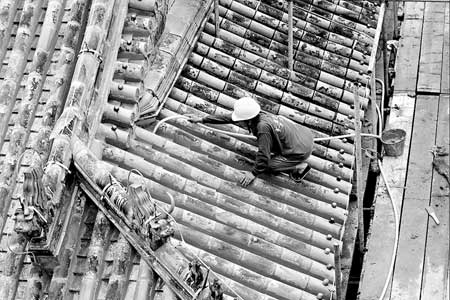Beijing is speeding up efforts to revamp centuries-old historic sites and the
city's symbolic hutong in preparation for the 2008 Olympic Games.
A short inauguration ceremony was held on Friday to mark the start of a
one-year project to restore the 600-year-old Imperial Ancestral Temple, adjacent
to the well-known Tian'anmen Rostrum in the west.
|

A worker prepares roof tiles for the
restoration of the 600-year-old Imperial Ancestral Temple in Beijing. The
one-year project will cost 15 million yuan (US$1.85 million). [China
Daily]
|
"With a total investment of 15 million yuan (US$1.85 million), it is the
largest restoration to the magnificent halls of the temple since liberation (in
1949)," said Kong Fanzhi, head of the Beijing Municipal Administration of
Cultural Heritage, at the ceremony.
An important part of the Forbidden City, the temple, renamed the Working
People's Cultural Palace after the founding of New China, mainly consists of
three magnificent halls, each with its own auxiliary halls.
"Workers will remove the cement used in the past to fill cracks in the
building, restore the ancient tiles and nails on the rooftops and restore the
mural paintings on the outer walls using traditional methods," he said.
Kong told reporters that restoration workers would use a type of paint
containing organic silicone to cover and protect the white marble sculptures
throughout the building.
"Basically speaking, we would not alter the tiles that cover the rooftops
during the renovation as well the frescoes on the walls of the halls," said Wang
Yuwei, an administration official in charge of cultural heritage protection.
"But the concrete floor tiles that were laid during the Cultural Revolution
(1966-76) would be replaced by the 'golden quadrels' as used in the Forbidden
City," he said.
During the Ming and Qing dynasties, on occasions such as an emperor ascending
to the throne, a triumphant return from battle or the presentation of prisoners
of war, the emperor would first come to the temple to offer sacrifices to his
ancestors.
Beijing has already begun restoration projects for 13 of 17 historical sites
this year, in accordance with an Olympics cultural protection programme, Kong's
administration said.
To maintain the original style of Beijing's hutong, the city recently adopted
a special policy on their environmental protection to guide restoration work.
The walls and rooms of a hutong must be painted a typical grey colour and be
built with traditional materials, while the layout should be maintained in its
original form.
The Dongcheng District has taken the lead in the restoration push, with plans
to renovate more than 100 hutong. By the end of July the district had already
given 69 hutong a facelift, strictly in accordance with the policy, reported the
Beijing-based Star Daily.